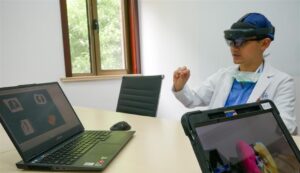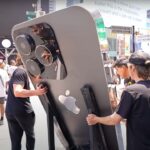Information technology is vast and has brought many inventions in almost every field. Artificial Intelligence plays a significant role in nearly every area. Whether we talk about media, financial institutes, education, or even Health is this everywhere, it has taken the field to the next level. The advancements in many sectors of the Health industry are enough to demonstrate the role of advanced technology, intelligent systems, and new Inventions.

Medical practitioners use their hands to manipulate an image of organs in the air while donning AR glasses connected to a digital system and penetrating a patient’s Chest wall using a long needle. The system enables visualization of the position and the depth of the needle puncture to successfully evaluate and analyze the pulmonary nodule accurately using a green line.
The process is taking place at the Shanghai Chest Hospital. However, Artificial intelligence has given doctors a new way to work efficiently and impose less pain and trouble on patients. With the advancement of technology, doctors can perform their tasks more efficiently. With the rise in clinical technology, minimally invasive surgery has been widely adopted in early-stage lung cancer surgery.
Pulmonary nodule localization is one of most patients’ most challenging and painful processes. The process is excruciating when doctors insert a long needle under the guidance of a CT scan to enter the chest wall and find the nodule. Regional Anesthesia is the only option that stays still while the long needle reaches the chest. Hence, the surgery is complex, and at least three medical staff need to be present on the spot; a nurse must follow the whole process and closely monitor the patient until the patient goes to the surgery room.
The process also imposes an extra workload on the CT room. Dr. Cheng Xinghua from Shanghai Chest Hospital Department of Oncology states, “The anxiety and pain patients suffer during the process was the biggest motivation for my team to team up with computer engineers from Xenova, a startup company in Shanghai, to develop a digital system to solve the issue.”
In addition, he also stated, “There is no longer any need to receive the CT-guided needle puncture. Patients are sent to the surgery room directly for a puncture under general anesthesia. It is a digital system fully developed by our doctors and engineers with complete intellectual property rights.”
Doctors develop a digital twin of the patient before surgery using the patient’s data. The system generates a digital patient structure with blood vessels, skin, tumors, and other internal information. The system creates an actual position, route, and accuracy of needle puncture. Doctors design surgery plans and even simulate various emergencies and adverse events during surgery to make pre-plans and preoperative training.
According to Cheng Xinghua, “The system can even stimulate lung collapse for doctors to try different medical solutions.”
By wearing AR glasses, all the organs, blood vessels, and surgery parts can easily be seen to get a clear picture through a 3D-Holographic format. Through this, doctors will be able to control the model confidently just by moving their hands. .oreoevr, it doesn’t need the CT room for preoperative localization but direct goes to the surgery room where the treatment is conducted under general anesthesia.
“Digital technology can help reduce cost and improve efficiency and effects,” Cheng said. In addition, he also stated, “By wearing the glasses, the system can show the puncture point and depth of needle we should insert into the chest wall. Then we must follow the guidance, and the whole process is finished within one minute. The patient needn’t receive radiation exposure or pain, while medical staff can save the process of going to the CT room. It brings benefit to patients and streamlines the medical process.”
The system currently holds five patents and has applied for industrial applications.
Cheng Xinghua, “The technology can not only be used in early-stage lung cancer surgery but other surgeries, such as liver surgery, brain surgery, and bone surgery, to provide an immersive guidance for surgeons and improve accuracy and efficiency.”
“For plastic surgery, the system can also forecast the result, allowing the doctor and the patient to understand better.”
Read more:
Pakistani Surgeon Dr. Amer Raza Sets World Record with Robotic Surgery
MWC 2019: Doctors perform surgery live via 5G





 YouTuber Creates World’s Largest Fully Functional iPhone: Here’s How
YouTuber Creates World’s Largest Fully Functional iPhone: Here’s How